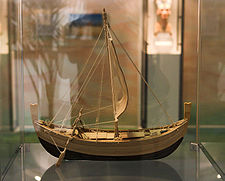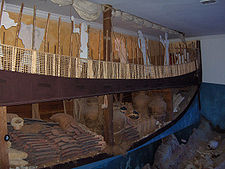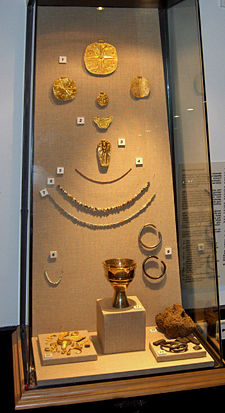
Uluburun shipwreck
Encyclopedia

Shipwreck
A shipwreck is what remains of a ship that has wrecked, either sunk or beached. Whatever the cause, a sunken ship or a wrecked ship is a physical example of the event: this explains why the two concepts are often overlapping in English....
dated to the late 14th century BCE, discovered off Uluburun (Grand Cape) situated about 6 miles southeast of Kaş
Kas
Kas is the brand name of soft drink produced by PepsiCo. It comes in grapefruit, orange , lemon , bitter , and apple flavors. Kasfruit juices are also offered in multiple flavors...
, in south-western Turkey
Turkey
Turkey , known officially as the Republic of Turkey , is a Eurasian country located in Western Asia and in East Thrace in Southeastern Europe...
. The shipwreck was first discovered in the summer of 1982 by Mehmed Çakir, a local sponge diver from Yalikavak
Yalikavak
Yalıkavak is a town near Bodrum in Muğla province, on the Aegean coast of Turkey. It is 18 km from Bodrum and located at the north eastern tip of the Bodrum peninsula...
, a village near Bodrum
Bodrum
Bodrum is a port city in Muğla Province, in the southwestern Aegean Region of Turkey. It is located on the southern coast of Bodrum Peninsula, at a point that checks the entry into the Gulf of Gökova. The site was called Halicarnassus of Caria in ancient times and was famous for housing the...
.
Eleven consecutive campaigns of three to four months duration took place from 1984 to 1994 totaling 22,413 dives, revealing one of the most spectacular Late Bronze Age assemblages to have emerged from the Mediterranean Sea
Discovery
The shipwreck site was discovered in the summer of 1982 due to Mehmet Çakir’s sketching of “the metal biscuits with ears” recognized as oxhide ingots. Turkish sponge divers were often consulted by the Institute of Nautical Archaeology’s (INA) survey team on how to identify ancient wrecks while diving for sponges. Çakir’s findings urged Oğuz Alpözen, Director of the Bodrum Museum of Underwater Archaeology, to send out an inspection team of the Museum and INA archaeologists to locate the wreck site. The inspection team was able to locate several amounts of copper ingots just 50 meters from the shore of Uluburun.Apparent route
With the evidence provided from the cargo on the ship it can be assumed that the ship set sail from either a Cypriot or Syro-Palestinian port. The Uluburun ship was undoubtedly sailing to the region west of CyprusCyprus
Cyprus , officially the Republic of Cyprus , is a Eurasian island country, member of the European Union, in the Eastern Mediterranean, east of Greece, south of Turkey, west of Syria and north of Egypt. It is the third largest island in the Mediterranean Sea.The earliest known human activity on the...
, but her ultimate destination can be concluded only from the distribution of objects matching the types carried on board. It has been proposed that perhaps the ship’s destination was Rhodes
Rhodes
Rhodes is an island in Greece, located in the eastern Aegean Sea. It is the largest of the Dodecanese islands in terms of both land area and population, with a population of 117,007, and also the island group's historical capital. Administratively the island forms a separate municipality within...
, which was at the time an important redistribution center for the Aegean.
Dating
Peter Kuniholm of Cornell University was assigned the task of dendrochronological dating in order to obtain an absolute date for the ship. The results date the wood at 1305 BCE, but given that no bark has survived it is impossible to determine an exact date and it can be assumed that the ship sank sometime after that date. Based on ceramic evidence, it appears that the Uluburun sank toward the end of the Amarna periodAmarna Period
The Amarna Period was an era of Egyptian history during the latter half of the Eighteenth Dynasty when the royal residence of the pharaoh and his queen was shifted to Akhetaten in what is now modern-day Amarna...
, but could not have sunk before the time of Nefertiti
Nefertiti
Nefertiti was the Great Royal Wife of the Egyptian Pharaoh Akhenaten. Nefertiti and her husband were known for a religious revolution, in which they started to worship one god only...
due to the unique gold scarab engraved with her name found aboard the ship. For now, it is concluded that the ship sank at the end of the 14th century BCE.
The objects aboard the ship range from northern Europe to Africa, and as far west as Sicily and as far east as Mesopotamia exhibiting products of nine or ten cultures. The presence of such cargo indicate that the Late Bronze Age Aegean was perhaps engaging in international trade based on royal gift-giving of the Near East.
The vessel

Even though there has been detailed examination of Uluburun’s hull, there has unfortunately been no evidence of its framing. The keel appears to be rudimentary, perhaps more of a keel-plank than a keel in the traditional sense. Dendrochronology has revealed that the ship was built with planks and keel of Lebanese cedar and oak tenons. Lebanese cedar is a tree indigenous to the mountains of Lebanon, southern Turkey, and central Cyprus.
The ship carried 24 stone anchors, which are of a type almost completely unknown in the Aegean, but are often found in the sea or built into the temples in Syria-Palestine and on Cyprus. Brushwood and sticks served as dunnage to help protect the ship’s planks from the heavy metal ingots and other cargo aboard.
Cargo
- This is a list of the cargo as described by Pulak (1998).
The Uluburun ship’s cargo consisted mostly of raw materials that were trade items, which before the ship’s discovery were known primarily from ancient texts or Egyptian tomb paintings. The cargo matches many of the royal gifts listed in the Amarna letters
Amarna letters
The Amarna letters are an archive of correspondence on clay tablets, mostly diplomatic, between the Egyptian administration and its representatives in Canaan and Amurru during the New Kingdom...
found at El-Amarna, Egypt
Egypt
Egypt , officially the Arab Republic of Egypt, Arabic: , is a country mainly in North Africa, with the Sinai Peninsula forming a land bridge in Southwest Asia. Egypt is thus a transcontinental country, and a major power in Africa, the Mediterranean Basin, the Middle East and the Muslim world...
.
- Copper and tin ingots
- Raw copper cargo totaling ten tons, consisting of a total of 354 ingots of the oxhide (rectangular with handholds extending from each corner) type.
- Out of the total amount of ingots at least 31 unique two-handled ingots were identified that were most likely shaped this way to assist the process of loading ingots onto specially designed saddles or harnesses for ease of transport over long distances by pack animals.
- 121 copper bun and oval ingots.
- The oxhide ingots were originally stowed in 4 distinct rows across the ship’s hold, which either slipped down the slope after the ship sank or shifted as the hull settled under the weight of the cargo.
- Approximately one ton of tin (when alloyed with the copper would make about 11 tons of bronze).
- Tin ingots were oxhide and bun shaped.
- Canaanite jars and Pistacia resin
- At least 149 Canaanite jars (widely found in Greece, Cyprus, Syria-Palestine, and Egypt).
- Jars are categorized as the northern type and were most likely made somewhere in the northern part of modern-day Israel.
- One jar filled with glass beads, many filled with olives, but the majority contained a substance known as Pistacia (terebinth) resin.
- Recent clay fabric analyses of Canaanite jar sherds from the 18th-Dynasty site of Tell el-Amarna have produced a specific clay fabric designation, and it is seemingly the same as that from the Uluburun shipwreck, of a type that is exclusively associated in Amarna with transporting Pistacia resin.
- Glass ingots
- Approximately 175 glass ingots of cobalt blue turquoise and lavender were found (earliest intact glass ingots known).
- Chemical composition of cobalt blue glass ingots matches those of contemporary Egyptian core-formed vessels and Mycenaean pendant beads, which suggests a common source.

- Miscellaneous cargo
- Logs of blackwoodAfrican BlackwoodDalbergia melanoxylon is a flowering plant in the family Fabaceae, native to seasonally dry regions of Africa from Senegal east to Eritrea and south to the Transvaal in South Africa....
from Africa (referred to as ebony by the Egyptians) - Ivory in the form of whole and partial elephant tusks
- More than a dozen hippopotamus teeth
- Tortoise carapaces (upper shells)
- Murex opercula (possible ingredient for incense)
- Ostrich eggshells
- Cypriot pottery
- Cypriot oil lamps
- Bronze and copper vessels (four faience drinking cups shaped as rams’ heads and one shaped as a woman’s head)
- Two duck-shaped ivory cosmetics boxesCosmetic container (vessel)A cosmetic container, cosmetic box, or cosmetic vessel is found in the historical records, both as an artifact, as relief items in some cultures, and are sometimes referenced in historical or archaeological literature. They are sometimes created in specific styles, shapes, or motifs.The named...
- Ivory cosmetics or unguent spoon
- Trumpet
- More than two dozen sea-shell rings
- Beads of amber (Baltic origin)
- Agate
- Carnelian
- Quartz
- Gold
- Faience
- Glass
- Logs of blackwood
- Jewelry, gold, and silver
- Collection of usable and scrap gold and silver Canaanite jewelry
- Among the 37 gold pieces are: pectorals, medallions, pendants, beads, a small ring ingot, and an assortment of fragments
- Biconical chalice (largest gold object from wreck)
- Egyptian objects of gold, electrum, silver, and steatite (soap stone)
- Gold scarab inscribed with the name of Nefertiti
- Bronze female figurine (head, neck, hands, and feet covered in sheet gold)
- Weapons and tools
- Arrowheads
- Spearheads
- Maces
- Daggers
- Lugged shaft-hole axe
- A single armor scale of Near Eastern type
- Four swords (Canaanite, Mycenaean, and Italian(?) types)
- Large number of tools: sickles, awls, drill bits, a saw, a pair of tongs, chisels, axes, a ploughshare, whetstones, and adzes
- Pan-balance weights
- 19 zoomorphic weights (Uluburun weight assemblage is one of the largest and most complete groups of contemporaneous Late Bronze Age weights)
- 120 geometric-shaped weights
- Foodstuffs
- Almonds
- Pine nuts
- Figs
- Olives
- Grapes
- Safflower
- Black cumin
- Sumac
- Coriander
- Whole pomegranates
- A few grains of charred wheat and barley
Excavation
The Institute of Nautical Archaeology (INA) began excavating in July of 1984 under the direction of its founder George F. Bass and was then turned over to INA’s Vice President of Turkey Cemal Pulak from 1985 to 1994. The wreck lay between 44 and 52 meters deep on a steep, rocky slope riddled with sand pockets. Half of the staff members whom aided in the excavation lived in a camp built into the southeastern face of the promontory that the ship most likely hit, while the other half of staff lived aboard the Virazon, INA’s research vessel at the time. The excavation site utilized an underwater telephone booth, air-lifts, and a horizontal stereo-bar. The mapping of the site was done by triangulation with meter tapes and metal squares to aid in the orientation for excavators. When the excavation was completed in September 1994 all efforts have been concentrated on full-time conservation, study, and sampling for analysis in the conservation laboratory in the Bodrum Museum of Underwater Archaeology in Turkey.Further reading
- Bass, George F. and others. “The Bronze Age Shipwreck at Ulu Burun: 1986 Campaign.” American Journal of Archaeology, Vol. 93, No.1 (Jan., 1989): 1-29.
- Mumford, Gregory D. “Mediterranean Area.” The Oxford Encyclopedia of Ancient Egypt. Ed. Donald B. Redford. Oxford University Press, Inc. 2001, 2005.
- Nicholson, Paul T., Caroline M. Jackson, Katherine M. Trott. “The Ulu Burun Glass Ingots, Cylindrical Vessels and Egyptian Glass.” Journal of Egyptian Archaeology, Vol.83 (1997): 143-153.
- Payton, Robert. “The Ulu Burun Writing-Board Set.” Anatolian Studies, Vol.41 (1991): 99-106.
- Ward, Cheryl. “Pomegranates in Eastern Mediterranean Contexts during the Late Bronze Age.” World Archaeology, Vol.34, No.3 (Feb., 2003): 529-541.
External links
- Dendrochronological Dating of the Uluburun Ship - Courtesy of the Institute of Nautical Archaeology.
- Uluburun shipwreck site for students - Courtesy of the Ellis School, Pittsburgh, PA and the Institute for Nautical Archaeology.
- The 1994 excavation at Uluburun: the final campaign by Cemal Pulak - Courtesy of the Institute of Nautical Archaeology.
- The home page of the Institute of Nautical Archaeology – Courtesy of the Institute of Nautical Archaeology.

